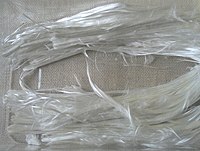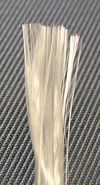Wikipedia:Reference desk/Archives/Science/2007 September 28
| Science desk | ||
|---|---|---|
| < September 27 | << Aug | September | Oct >> | September 29 > |
| Welcome to the Wikipedia Science Reference Desk Archives |
|---|
| The page you are currently viewing is an archive page. While you can leave answers for any questions shown below, please ask new questions on one of the current reference desk pages. |
September 28[edit]
[edit]
What does BMT stand for? —Preceding unsigned comment added by 84.64.122.81 (talk) 03:50, 28 September 2007 (UTC)
- "Biggest, Meatiest, Tastiest", with a nod towards "Brooklyn-Manhattan Transit." --Mdwyer 04:07, 28 September 2007 (UTC)
- Back when the names of the sandwiches were taken from subway lines, it did stand for Brooklyn Manhattan Transit. They moved away from the naming scheme but that one stuck. At least that's what the Subway manager I spoke to told me when I asked this years ago. Dismas|(talk) 15:47, 28 September 2007 (UTC)
- Subway's own website plays coy:
- "Italian B.M.T.® An old-world favorite. Sliced Genoa salami, pepperoni and ham and your choice of fresh vegetables and condiments served on freshly baked bread. Some say BMT stands for biggest, meatiest, tastiest. We wouldn’t disagree."
- I've also seen "Bigger, meatier, tastier" on in-store posters, though not recently. TenOfAllTrades(talk) 16:00, 28 September 2007 (UTC)
I've been reading the Transverse Doppler effect article, and I just don't get what it's saying. If the redshift factor is , then does that mean that the factor is less than one and an object moving laterally appears redshifted to the observer? 18.238.6.77 04:06, 28 September 2007 (UTC)
- Have you noticed that there is an article on the relativistic Doppler effect, and it even has colourful figures and animations. Looking a bit at these will show you that, yes, an object moving laterally gets redhsifted a bit, too. See relativistic beaming for something even stranger. 138.232.67.15 12:17, 28 September 2007 (UTC)
Fibreglass for oven insulation[edit]
This probably isn't the best place to ask but what the heck... After my stupid cat brought in and lost one (or more) mice in my house, it evidentally took up nest in the oven. Today when I turned it on (mostly use the elements), the heat and/or air movement because of the heat caused the outside to stink terribly (inside it smelled fine). After finally working out how to take the damn thing apart I decided the fibreglass insulation which had some holes in some places had probably been contaminated and it was unlikely I could get the smell off so I removed it. I now of course have to replace the insulation if I don't want to waste a lot of electricity.
Does anyone know if you need special high temperature fibreglass or most stuff will be fine (obviously wool or something is a bad idea). I have some left over from a water heater job but which looks more or less the same but of course that only needs to work at 100 C whereas this will in theory get close to 250C in some cases.
N.B. The often is fairly old so if worse comes to worse it can be replaced. Hopefully I can put I back together okay
Nil Einne 15:09, 28 September 2007 (UTC)
- YIKES! Are you sure that's fibreglass and not some kind of asbestos wool? The latter is not stuff you'd want to be messing with! Asbestos fibre looks almost identical to fibreglass - it's much more temperature-resistant and if your oven is old then it may well have been made before the stuff was banned. Asbestos is a nasty health hazard. I don't know if that's what you have here (obviously) - but then, neither do you - so for sure wear a mask and (even if it's only fibreglass), you should certainly wear gloves! SteveBaker 15:33, 28 September 2007 (UTC)


- Asbestos thermal insulation really doesn't look much like the fiberglass used in ovens, but your suggestion of caution is still welcomed. Having said that, I'll make three observations and a suggestion:
- The insulation may not be just for efficiency. It may be for safety, as in keeping the exterior of the oven at a low-enough temperature so as not to cause thermal burns and light the kitchen cabinets, floors, etc. on fire. Don't omit it!
- For a self-cleaning oven that uses pyrolytic decomposition, you need insulation that will go a lot higher than 250C, more like 500-560C.
- I personally wouldn't trust "improvised" insulation so I'd go to my nearest appliance parts dealer and try to buy replacement appropriate insulation board which you could then cut to shape.
- Asbestos thermal insulation really doesn't look much like the fiberglass used in ovens, but your suggestion of caution is still welcomed. Having said that, I'll make three observations and a suggestion:
- Atlant 15:51, 28 September 2007 (UTC)
- I'm pretty sure it's not asbestos because amongst other things asbestos has been more or less completely banned in NZ since 1987 AFAIK, altho the regulations were fairly strict before then anyway (since the early 80s or so I think). And the oven is old but I don't think it's that old. Also as Atlant said (although I've no experience in recognising asbestos) I don't think it looks like fibreglass. It's not a Self-cleaning oven BTW, it's not that fancy although it did seem to be quite well insulated (from experience of how well it kept the heat when off). Nil Einne 16:55, 28 September 2007 (UTC)
- You're probably right - you said the oven was old...but not how old...and I felt it better to be "safe, quickly" than to do a whole lot of research. Anyway, I strongly disagree about asbestos and fibreglass looking different - check out the two photos from our asbestos and fibreglass articles respectively. I couldn't tell the difference. SteveBaker 18:16, 28 September 2007 (UTC)
- Perhaps in their "raw" form, but as a final product, I still think they're pretty unmistakable. For example, I've never seen pink asbestos ;-), and even the more-common fiberglass "yellow" color is pretty unique to fiberglass. Asbestos and rock wool tended to be used in their natural colors.
- Atlant 19:14, 28 September 2007 (UTC)
Insect identification[edit]
Can anyone identify this... thing? It was seen in Vermont. It's about 3-4" long and about 3/4" in diameter. Sorry for the crappy cell phone pics... [1] [2] [3] [4] Thanks, Dismas|(talk) 16:57, 28 September 2007 (UTC)
- I'm no bugologist, but it looks like a Sphinx Moth caterpillar, perhaps a Eumorpha pandorus. Was he by any chance munching on a grape vine? There are some nice pics of them here. Some Eumorpha do an absurdly good job of tricking birds into thinking they're snakes: [5], [6] (!). --Sean 18:09, 28 September 2007 (UTC)
- Kind of close but I don't recall the one I saw having that horn on the head. Oh, and a "bugologist" would be an entomologist. Dismas|(talk) 22:21, 28 September 2007 (UTC)
- Kind of close, but an entomologist studies insects, which are a subset or superset of bugs depending on your vantage point. There are many bugs which aren't insects and true bugs are studied by hemipterologists. --Rajah 01:33, 29 September 2007 (UTC)
- Kind of close but I don't recall the one I saw having that horn on the head. Oh, and a "bugologist" would be an entomologist. Dismas|(talk) 22:21, 28 September 2007 (UTC)
preproprotein[edit]
Can you please add a definition for preproprotein and examples? thanks208.146.45.110 17:46, 28 September 2007 (UTC)
- Wikipedia has a fairly long article on insulin, but does not do a very good job of explaining the preproinsulin molecule. Most peptide hormones and neuropeptides are derived from preproproteins that use a signal peptide to interact with signal recognition particles and gain entry into the endoplasmic reticulum. After the signal peptide is cleaved from the preproproteins, the prohormone must be further processed to produce a functioning signal molecule that can bind to its receptor. Proopiomelanocortin is derived from preproopiomelanocortin. The articles on oxytocin and cholecystokinin also indicate that they are produced from a larger preproproteins. --JWSchmidt 19:55, 28 September 2007 (UTC)
- Proprotein is also currently without an article. The Transhumanist 20:31, 28 September 2007 (UTC)
- I just added redirects for proprotein and preproprotein to protein precursor. I also described prepropeptides there. The pre- prefix should be elaborated upon at either signal peptide or protein targeting, in my opinion. --David Iberri (talk) 01:25, 29 September 2007 (UTC)
Hunger and grumpiness[edit]
Howdy, does anyone know why huger leads to being grumpy, irritable, or otherwise tetchy? I'm curious about both the biochemical cause (is there some hormone release?) or evolutionary (ultimate) cause would be greatly appreciated. Thanks, --TeaDrinker 20:31, 28 September 2007 (UTC)
- I’ll go out on a limb and hypothesize that it may be caused by very mild hypoglycemia (low blood sugar) due to not eating for an unusual stretch of time. Although the article points out that blood plasma glucose levels are usually maintained at about 70-140 mg/dL throughout the day in healthy humans, if a person breaks from their routine (skips a meal for instance) the unaccustomed fasting could cause the blood sugar level to dip. --S.dedalus 23:51, 28 September 2007 (UTC)
Geos[edit]
Hi. The article, Geo (landscape) states that the term is only used in Shetland and Orkney Islands but Im quite sure that the term can also be used to refer to similar features in England. For example clefts formed when chalk caves on the coast collapse in. An example being on Flamborough head, Yorkshire. Could someone help me out here? Tbo 157(talk) (review) 22:03, 28 September 2007 (UTC)
- The OED says "In Orkney and Shetland: A gully, a creek. Also, in wider use: a long, narrow, steep-sided cleft or inlet formed by erosion in coastal cliffs, and typically represented by the geos of Orkney." I haven't found an example applied to Flamborough, though. --ColinFine 19:43, 6 October 2007 (UTC)

